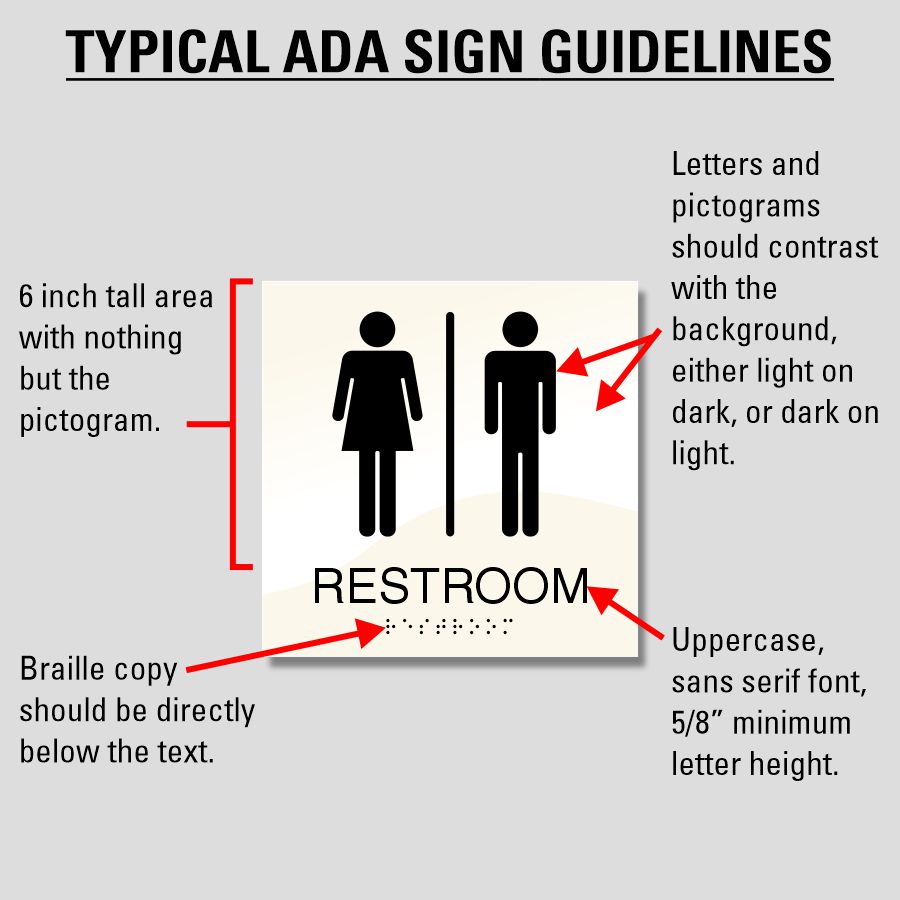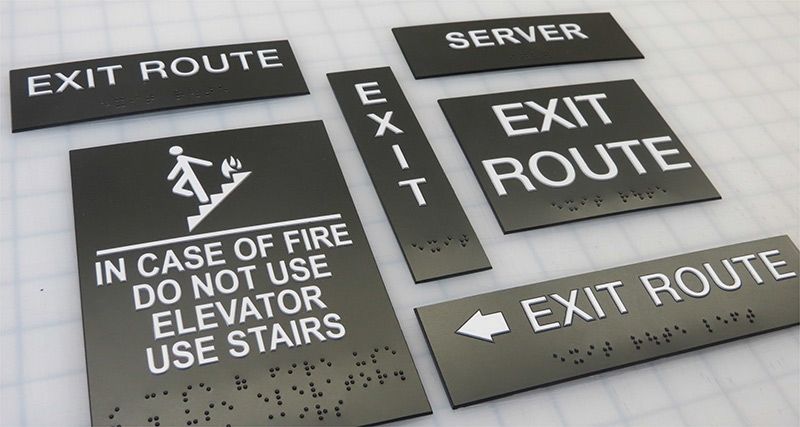Comprehending the Regulations Behind ADA Signs
Comprehending the Regulations Behind ADA Signs
Blog Article
Exploring the Key Features of ADA Signs for Enhanced Access
In the world of access, ADA indicators offer as silent yet powerful allies, guaranteeing that spaces are navigable and comprehensive for individuals with impairments. By integrating Braille and tactile components, these indicators damage obstacles for the visually impaired, while high-contrast color pattern and understandable font styles deal with varied visual needs. Their calculated placement is not approximate however rather a computed effort to facilitate seamless navigating. Beyond these attributes exists a much deeper narrative concerning the development of inclusivity and the ongoing dedication to producing fair areas. What more could these indicators represent in our search of universal ease of access?
Significance of ADA Conformity
Ensuring conformity with the Americans with Disabilities Act (ADA) is important for promoting inclusivity and equivalent accessibility in public rooms and workplaces. The ADA, enacted in 1990, mandates that all public centers, companies, and transportation solutions suit people with specials needs, guaranteeing they delight in the exact same rights and possibilities as others. Conformity with ADA requirements not only satisfies legal commitments yet additionally enhances a company's online reputation by demonstrating its dedication to diversity and inclusivity.
One of the crucial facets of ADA conformity is the execution of accessible signs. ADA indicators are designed to ensure that people with handicaps can conveniently browse through structures and spaces.
Additionally, sticking to ADA policies can mitigate the threat of lawful consequences and potential penalties. Organizations that stop working to follow ADA standards may encounter claims or charges, which can be both destructive and economically troublesome to their public picture. Hence, ADA conformity is important to promoting an equitable environment for everyone.
Braille and Tactile Aspects
The incorporation of Braille and tactile components right into ADA signage symbolizes the concepts of accessibility and inclusivity. It is usually positioned beneath the matching message on signs to guarantee that people can access the information without aesthetic aid.
Responsive aspects prolong beyond Braille and include increased symbols and characters. These parts are made to be noticeable by touch, permitting people to determine space numbers, washrooms, exits, and other critical locations. The ADA establishes certain guidelines regarding the dimension, spacing, and positioning of these tactile aspects to enhance readability and ensure uniformity throughout various settings.

High-Contrast Color Design
High-contrast color pattern play a crucial function in enhancing the visibility and readability of ADA signs for individuals with visual problems. These plans are vital as they make best use of the difference in light reflectance in between message and background, guaranteeing that signs are conveniently discernible, also from a distance. The Americans with Disabilities Act (ADA) mandates making use of certain color contrasts to fit those with limited vision, making it an important facet of compliance.
The efficacy of high-contrast shades depends see this on their ability find out this here to attract attention in numerous lights problems, including dimly lit atmospheres and areas with glow. Typically, dark text on a light background or light message on a dark background is used to attain optimal comparison. Black message on a yellow or white background offers a raw visual difference that assists in quick recognition and understanding.

Legible Fonts and Text Dimension
When considering the layout of ADA signs, the choice of legible typefaces and appropriate text dimension can not be overstated. The Americans with Disabilities Act (ADA) mandates that fonts must be sans-serif and not italic, oblique, manuscript, very attractive, or of unusual form.
The dimension of the message likewise plays a critical role in ease of access. According to ADA guidelines, the minimum message elevation ought to be 5/8 inch, and it must enhance proportionally with seeing distance. This is specifically vital in public rooms where signage demands to be reviewed quickly and precisely. Uniformity in text dimension contributes to a natural aesthetic experience, aiding people in navigating settings effectively.
Additionally, spacing in between letters and lines is integral to clarity. Adequate spacing stops characters from appearing crowded, boosting readability. By adhering to these criteria, designers can substantially improve access, guaranteeing that signs serves its designated purpose for all individuals, no matter their visual capacities.
Effective Positioning Strategies
Strategic positioning of ADA signs is vital for making best use of availability and ensuring compliance with lawful standards. Properly positioned indicators assist individuals with handicaps properly, helping with navigation in public areas. Secret factors to consider consist of exposure, elevation, and closeness. ADA guidelines specify that indicators need to be mounted at a height between 48 to 60 inches from the ground to ensure they are within the line of sight for both standing and seated individuals. This common elevation array is critical for inclusivity, allowing wheelchair users and individuals of varying heights to gain access to info effortlessly.
In addition, signs have to be put nearby to the latch side of doors to enable simple identification before access. Consistency in sign positioning throughout a center boosts predictability, lowering complication and improving general customer experience.

Final Thought
ADA indications play a vital function in advertising availability by integrating functions that address the requirements of individuals with specials needs. Incorporating Braille and tactile elements guarantees important details comes to the visually impaired, while high-contrast color pattern and clear sans-serif font styles improve presence throughout different lighting conditions. Effective placement approaches, such as proper placing elevations and critical areas, further assist in navigation. These components collectively promote an inclusive atmosphere, emphasizing the relevance of ADA compliance in guaranteeing equivalent accessibility for all.
In the world of ease of access, ADA indicators offer as quiet yet effective allies, making sure that rooms are accessible and comprehensive for individuals with disabilities. The ADA, established in 1990, mandates that all public facilities, companies, and transportation solutions fit people with handicaps, guaranteeing they take pleasure in the very same legal rights and chances as others. ADA Signs. ADA signs are made to make certain that individuals with disabilities can conveniently browse through structures and areas. ADA guidelines stipulate that indicators must be mounted at an elevation between 48 to 60 inches from the ground to ensure they are within the line of view for both standing and seated individuals.ADA signs play an important role in advertising access by integrating features that address the demands of people with impairments
Report this page